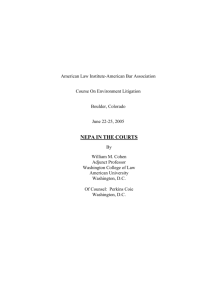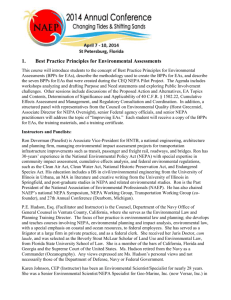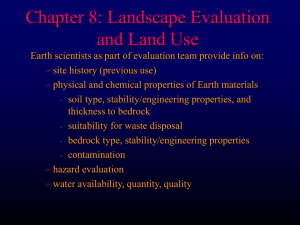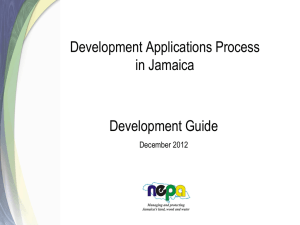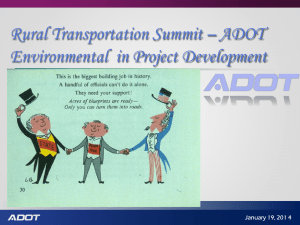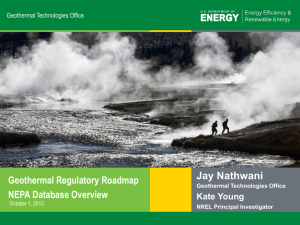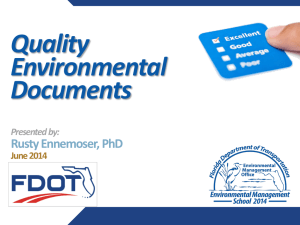PowerPoint Presentation Template 3, Landscape - COPAS
advertisement
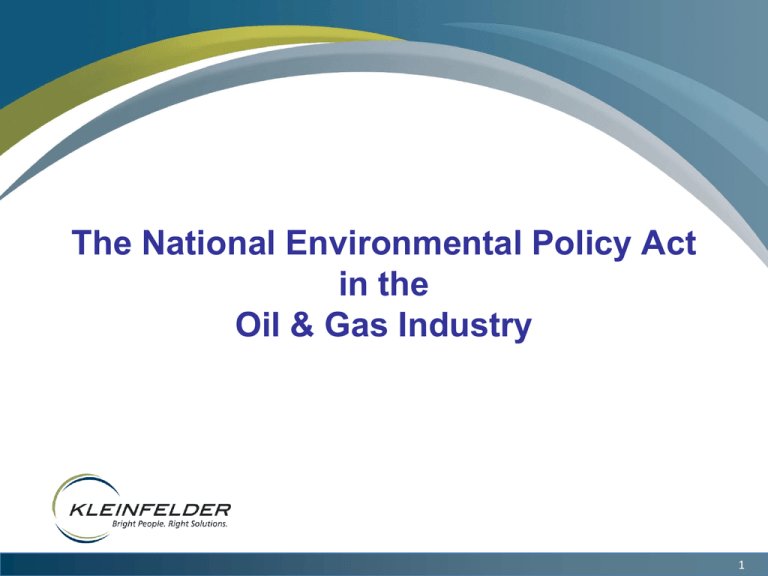
The National Environmental Policy Act in the Oil & Gas Industry 1 Who are we? Kleinfelder is a 53-year-old employeeowned architecture, engineering, and science consulting firm with over 1,700 employees and 65 offices in the US, Canada, and Australia. 25 years providing engineering and environmental solutions to upstream, midstream, and downstream clients. Presence in all the major domestic and Canadian oil and gas plays. 2 What we are going to cover? Regulatory framework of NEPA. Schedule and Costs. 3 Regulatory Framework of NEPA The National Environmental Policy Act (NEPA) was enacted in 1970. NEPA is our nation’s charter for protection of the environment. NEPA process is intended to help public officials make better decisions about actions on public lands (NEPA is not intended to be an environmental group obstruction tool but frequently is). 4 What triggers NEPA? Any federal action that has the potential to affect the human environment is subject to analysis under NEPA. 5 Federal Action = Any activity that requires federal agency approval, permitting, and/or funding Typical O&G federal actions: • Drilling federal or Tribal minerals. • Building ROW across federal or Tribal lands. • Drilling wells on State lands funded by federal dollars. 6 Human Environment = The natural and physical environment and relationship of people with that environment Typical effects that may trigger requirement for analysis under NEPA: • • • Surface disturbance Habitat loss Noise impacts • • • Socioeconomic benefits Changes in traffic patterns Air quality effects and more…. 7 Definition of “human environment” allows for a lot of discretion in determining whether a federal action will have an effect that requires analysis under NEPA. When an agency determines that a federal action may affect the human environment, they are required under NEPA to evaluate and disclose those potential impacts to the public. 8 Types of NEPA Documents Environmental Assessment (EA) Environmental Impact Statement (EIS) Categorical Exclusions (CE or CX) Documentation of NEPA Adequacy (DNA) Given time constraints we will only be discussing EAs and EISs. 9 Environmental Assessment Under NEPA and CEQ definitions, an EA addresses an action where the significance of social, economic, or environmental impact is not clearly established. In practice, an EA is written when the agency is fairly confident that the action will not have “significant” effects on the human environment. 10 Environmental Assessment Thresholds for determining “significance” often not clearly defined. E.g., a violation of federal CAA or CWA standards could be significant but how do you determine whether impacts to “recreational experience” is significant? Agencies have tremendous discretion in deciding whether or not to prepare an EA, or go straight to the more time consuming and costly EIS process. Decision is often heavily influenced by external pressures (e.g., from other agencies like EPA, environmental groups). 11 Environmental Assessment • EAs will often include voluntary mitigation to avoid significant impacts, and hence avoid having to do an EIS: • e.g., upfront surveys for threatened or endangered plants, archaeological clearance surveys. 12 Environmental Assessment If no significant impact is determined, a Finding of No Significant Impact (FONSI) is prepared and, depending on the agency, included within a Decision Record / Decision Memo. If the action analyzed in an EA is determined to have significant impacts then an EIS must be prepared. 13 Environmental Impact Statement Addresses an action likely to have significant impacts. The scope and schedule for EISs can vary dramatically among agencies, but are generally much more in-depth and longer than EAs. Projects analyzed in an EIS can have and are presumed to have significant impacts (reminder - in an EA there cannot be “significant” impacts). 14 Environmental Impact Statement EISs involve multiple, time-consuming steps required by regulation. Lengthy agency review of public notifications in the Federal Register 6- to 12-month alternative development phase 30- to 60-day public scoping period 30- to 60-day EIS comment periods All of which result in a lengthy completion process: 3-7 years for most O&G EISs in western U.S. 15 Connected Action Connected action is a term frequently heard when discussing EAs or EISs and merits definition… Connected actions are actions that are interdependent; one action depends on another action for their justification. Connected actions must be analyzed in the EA or EIS. Pipeline that begins at a well pad on Federal surface, and crosses onto privately-owned surface estate. Wells with privately owned surface and mineral estate that use the same proposed ROWs as wells on Federal surface or mineral estate. Underground injection control (UIC) wells on private surface estate that will be used for disposal of produced water from federal mineral estate wells. 16 NEPA Process Participants Federal Lead Agency – Such as BLM, BIA, or USFS The Proponent/Applicant – The Operator Third-Party Contractor – The Consultant Cooperating Agencies (CAs) – Entities with legal jurisdiction; State Agencies, Counties, Indian Tribes, Other Federal Agencies (Fish & Wildlife Service, Environmental Protection Agency) Consulting Parties (CPs) – Entities with unique expertise; e.g., non-governmental organizations The Public – Environmental Groups, Landowners, Interested Citizens 17 Cost and Schedule Operators are frequently caught off-guard by NEPA requirements and associated costs and timing. Costs can range depending on the type of NEPA document, scale of proposed development, location of the project, issues or resources within your project area, and the agency and/or agency personnel you are working with. 18 Typical NEPA costs: EAs: $25,000 - $500,000 EISs: $1,000,000 - $6,000,000+ Ancillary costs may include civil, biological, cultural, and paleontological surveys; stream and wetland delineations; and modeling $5,000 - $2,000,000+ Why does NEPA compliance cost so much? Complicated impact assessment models for air and water quality. Extensive coordination between consultant, agency, and operator. Significant labor hours to author the document. 19 Schedule for NEPA projects vary depending on the agency, issues associated with your project, and delays related to other agency priorities. Typical timeframes: EAs: 6 months to 3 years EISs: 3 to 7 years Schedule is heavily influenced by the operator and the agency. 20 Example EA Process Flow Chart With Agency Touch Points Agency IDT Conduct Scoping Project Kickoff Develop Alternatives Agency Review Agency Review Publish Draft EA Solicit Public Comments Agency Review Agency Review Respond to Comments Conduct and Analyze Data Publish Final EA Issue FONSI or Prepare EIS 21 Conclusions In practice, NEPA compliance is guided by statute, regulation, politics, and personalities. The human element has salient effect on how individual NEPA projects are implemented, how long they take, and how much they cost. Critical to understand agency-specific guidelines and office-specific “guidelines” for NEPA compliance. Critical to build schedule and cost expectations into drilling plans. Critical to be informed and engaged throughout process. 22 Questions? Contact Information: Dawn Martin 303-916-0354 DMartin@Kleinfelder.com 23

